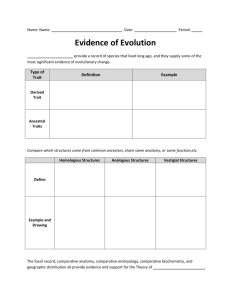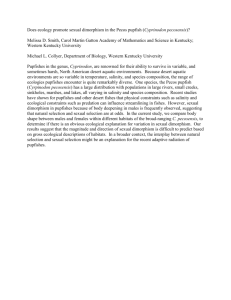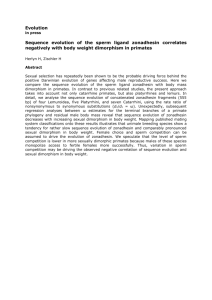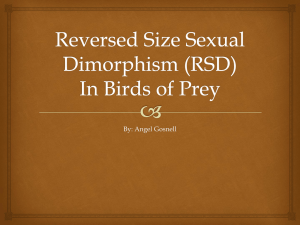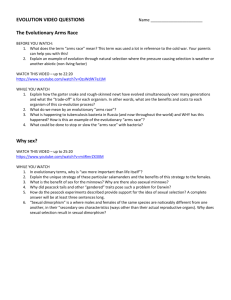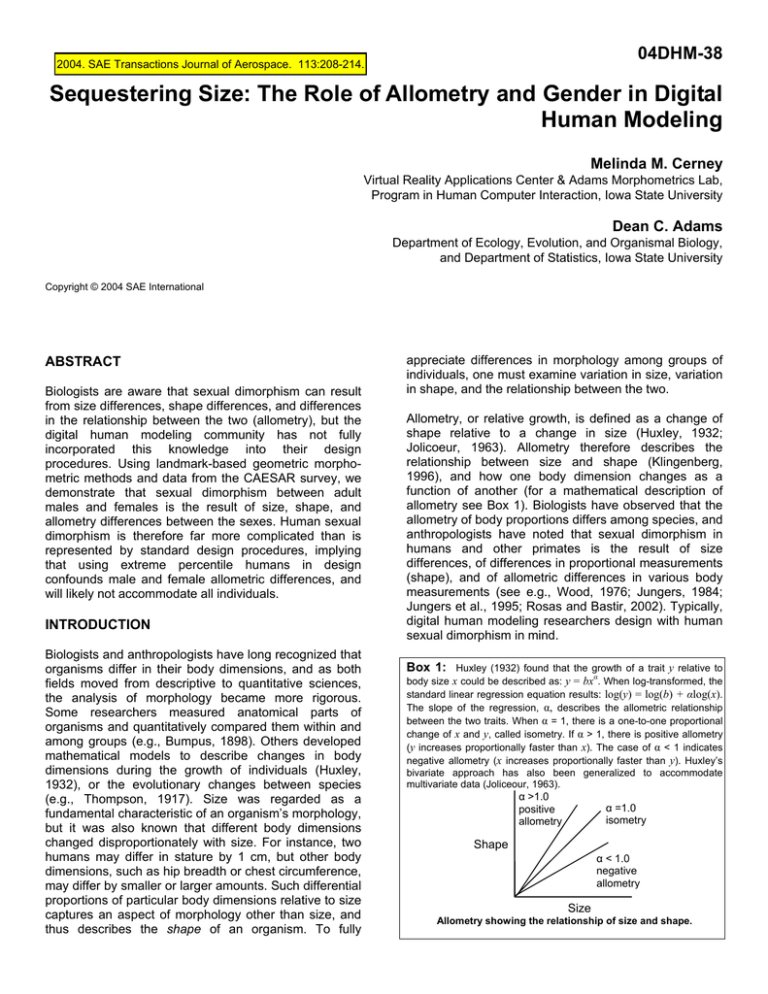
04DHM-38
2004. SAE Transactions Journal of Aerospace. 113:208-214.
Sequestering Size: The Role of Allometry and Gender in Digital
Human Modeling
Melinda M. Cerney
Virtual Reality Applications Center & Adams Morphometrics Lab,
Program in Human Computer Interaction, Iowa State University
Dean C. Adams
Department of Ecology, Evolution, and Organismal Biology,
and Department of Statistics, Iowa State University
Copyright © 2004 SAE International
ABSTRACT
Biologists are aware that sexual dimorphism can result
from size differences, shape differences, and differences
in the relationship between the two (allometry), but the
digital human modeling community has not fully
incorporated this knowledge into their design
procedures. Using landmark-based geometric morphometric methods and data from the CAESAR survey, we
demonstrate that sexual dimorphism between adult
males and females is the result of size, shape, and
allometry differences between the sexes. Human sexual
dimorphism is therefore far more complicated than is
represented by standard design procedures, implying
that using extreme percentile humans in design
confounds male and female allometric differences, and
will likely not accommodate all individuals.
INTRODUCTION
Biologists and anthropologists have long recognized that
organisms differ in their body dimensions, and as both
fields moved from descriptive to quantitative sciences,
the analysis of morphology became more rigorous.
Some researchers measured anatomical parts of
organisms and quantitatively compared them within and
among groups (e.g., Bumpus, 1898). Others developed
mathematical models to describe changes in body
dimensions during the growth of individuals (Huxley,
1932), or the evolutionary changes between species
(e.g., Thompson, 1917). Size was regarded as a
fundamental characteristic of an organism’s morphology,
but it was also known that different body dimensions
changed disproportionately with size. For instance, two
humans may differ in stature by 1 cm, but other body
dimensions, such as hip breadth or chest circumference,
may differ by smaller or larger amounts. Such differential
proportions of particular body dimensions relative to size
captures an aspect of morphology other than size, and
thus describes the shape of an organism. To fully
appreciate differences in morphology among groups of
individuals, one must examine variation in size, variation
in shape, and the relationship between the two.
Allometry, or relative growth, is defined as a change of
shape relative to a change in size (Huxley, 1932;
Jolicoeur, 1963). Allometry therefore describes the
relationship between size and shape (Klingenberg,
1996), and how one body dimension changes as a
function of another (for a mathematical description of
allometry see Box 1). Biologists have observed that the
allometry of body proportions differs among species, and
anthropologists have noted that sexual dimorphism in
humans and other primates is the result of size
differences, of differences in proportional measurements
(shape), and of allometric differences in various body
measurements (see e.g., Wood, 1976; Jungers, 1984;
Jungers et al., 1995; Rosas and Bastir, 2002). Typically,
digital human modeling researchers design with human
sexual dimorphism in mind.
Box 1:
Huxley (1932) found that the growth of a trait y relative to
α
body size x could be described as: y = bx . When log-transformed, the
standard linear regression equation results: log(y) = log(b) + αlog(x).
The slope of the regression, α, describes the allometric relationship
between the two traits. When α = 1, there is a one-to-one proportional
change of x and y, called isometry. If α > 1, there is positive allometry
(y increases proportionally faster than x). The case of α < 1 indicates
negative allometry (x increases proportionally faster than y). Huxley’s
bivariate approach has also been generalized to accommodate
multivariate data (Joliceour, 1963).
α >1.0
positive
allometry
α =1.0
isometry
Shape
α < 1.0
negative
allometry
Size
Allometry showing the relationship of size and shape.
Figure 1 provides a simple example. Here seated hip
breadth and shoulder breadth are plotted for the 1st, 50th,
and 99th percentile male and female manikins (Tilley,
1993). Connecting the small and large individuals of
males and females provides a representation of the
allometry of shoulder breadth relative to seated hip
breadth. These relationships differ between males and
females (bmale = 0.80; bfemale = 0.46). When the 1st
percentile female and 99th percentile male are used, the
allometry between shoulder breadth and seated hip
breadth is bjoint = 1.09. Similar results were found when
percentile values for individual body measurements
were used. Clearly, design specifications based upon
the 1st percentile female and the 99th percentile male
generate an allometric trajectory that is not
representative of either that of males or females.
Additionally, this design specification fails to
accommodate large females and small males, as they
fall outside the confidence intervals of this jointlygenerated relationship. Clearly, a more rigorous
treatment of morphological variability in males and
females could improve DHM design.
This simple example shows that there are components
of sexual dimorphism that are not captured by percentile
designs. An unexamined question however is to what
extent this phenomenon is present in more
comprehensive data sets, where human body shape is
represented by more complex, multivariate data. In this
paper, we quantified morphological variation using the
North American Civilian American and European
Surface Anthropometry Resource (CAESAR) to examine
sexual dimorphism in body size, body shape, and
allometry. We then discuss the implications of these
findings for DHM design specifications.
22
21
20
19
Shoulder Breadth (in)
The fields of human factors and digital human modeling
(DHM) recognize sexual dimorphism in adults.
Numerous interpopulational and intercontinental studies
have verified sexual dimorphism in linear body
dimensions through the comparison of height, sitting
height, shoulder width, hip width, and other
anthropometric measurements (Tanner, 1962; Tanner et
al., 1976; Hiernaux, 1985; Hauspie et al., 1985). These
results have important consequences for design, and
separate design standards are generally provided for
men and women. Unfortunately, while DHM designs
attempt to account for human sexual dimorphism, the
manner in which this is done is incomplete because the
sexual dimorphism is not decomposed into its relative
components of body size dimorphism, body shape
dimorphism, and allometric dimorphism. Perhaps most
common are the use of manikins to represent the
physical and body pivot dimension limits for a specific
percentage of the population (e.g. the 5th percentile
female and the 95th percentile male). These manikins,
like those recommended by the Society of Automotive
Engineers (SAE J833, 1989) and the International
Organization for Standards (ISO 3411:1995, 1995), are
chosen to represent the extremes of body dimension
variability, but their use fails to capture the allometric
changes in body dimensions of both males and females.
18
17
16
15
14
Male (Tilley, 1993)
Female (Tilley, 1993)
Design Range
13
Confidence Interval
12
10
11
12
13
14
15
16
17
18
19
Seated Hip Breadth (in)
Figure 1: Representative allometric trajectories of shoulder breadth
versus seated hip breadth for males and females (data from Tilley,
st
th
th
1993). Trajectories generated using 1 , 50 , and 99 percentile
manikins (confidence intervals estimated using summary data of US
Army men, 1988).
METHODS
Data were obtained from the North American CAESAR
survey, encompassing subjects between the ages of 18
and 65 (Robinette, et al., 2002). Three-dimensional
surface scans were acquired for all CAESAR
participants in a standing, seated working, and seated
coverage position (resolution of a few mm). The
locations of 73 anatomical landmark locations were
derived from these scans and recorded for each subject
(Robinette, 1999). Nineteen landmarks from the
standing posture data were selected for this study
(Figure 2). These landmarks were chosen for their ability
to
describe
overall
body
shape
and
their
correspondence to endpoints of commonly-used
distance measures. Our data set comprised 2344 adult
subjects, including 1103 males and 1241 females.
Landmark-based
geometric
morphometric
(GM)
techniques were used to quantify body shape (Rohlf and
Marcus, 1993; Adams et al., 2004). Recent work in DHM
has begun to include the tools of geometric
morphometric methods for evaluating body shape
differences and visualizing digital human models
(Cerney, 2003; Cerney, Adams & Vance, 2003; Friess,
Rohlf, & Hsiao, 2003). GM methods are preferable to
methods quantifying body shape using sets of linear
distances because the geometric relationships among
the variables are preserved throughout the analysis.
With this approach, morphology was first quantified
using a set of homologous landmarks. Unfortunately,
direct analysis of the landmark coordinates was not
possible, as they contained components of both shape
and non-shape variation. Non-shape variation was
therefore removed using Generalized Procrustes
Analysis, or GPA (Gower, 1975; Rohlf and Slice, 1990).
GPA removed differences in scale, position, and
orientation by scaling all subjects to unit size, translating
them to a common location, and rotating them so that
corresponding landmarks lined up as closely as
possible. After GPA superimposition, each
No.
1
2
3
4
5
6
7
8
9
10
11
12
13
14
15
16
17
18
19
Landmark
Sellion
Suprasternum
R. Iliac Crest
L. Iliac Crest
R. Acromion
R. Olecranon
R. Dactylion
R. Ulnar Styloid
L. Acromion
L. Olecranon
L. Dactylion
L. Ulnar Styloid
R. Femoral Epicondyle, Lateral
R. Digit II
R. Calcaneus Posterior
L. Femoral Epicondyle, Lateral
L. Digit II
L. Calcaneus Posterior
Crotch
Figure 2: (Left) Standing posture CAESAR body scan. (Center)
Landmarks identified for a representative subject. (Right) Description of
three-dimensional landmarks.
subject was represented by a dot in a curved, nonEuclidean shape space. The aligned subjects were then
projected orthogonally into a linear tangent space, with
the consensus subject describing the point of tangency
(Rohlf, 1996). A set of shape variables (Kendall’s
tangent space coordinates: Rohlf, 1999) were then
obtained using principal component analysis (PCA),
which eliminated redundant dimensions standardized by
GPA. These shape variables are mathematically
equivalent to the set of partial warp scores and uniform
shape components commonly used in GM analyses
(Bookstein, 1991; 1996; Rohlf and Bookstein, 2003), and
can be used in statistical comparisons of shape variation
within and among groups (see e.g., Caldecutt and
Adams, 1998; Adams and Rohlf, 2000; Rüber and
Adams, 2001; Kassam et al., 2003). Using GPA, the size
of each subject was calculated as centroid size, the
square root of the sum of the squared inter-landmark
distances (Bookstein, 1991), and was retained for further
analysis. GM analyses were performed in Morpheus et
al. (Slice, 1998) and NTSYSpc (Rohlf, 2000).
Several statistical procedures were used to investigate
sexual dimorphism in the data set. First, to determine
whether body size varied significantly between genders,
a student’s t-test of centroid size was performed. The
degree of correspondence between centroid size and
two common DHM measurements—stature and
weight—was also assessed using regression analysis.
Sexual dimorphism in shape was first examined
graphically, using the first two principal components of
shape variation. We then determined whether body
shape varied significantly between genders using a
multivariate analysis of variance (MANOVA). The
allometry of body shape was compared between males
and females, using a multivariate analysis of covariance
(MANCOVA), where body size was the covariate. With
this analysis a significant interaction between body size
and gender would reveal that allometry differed
significantly between the sexes. Finally, the allometric
trajectories of body shape for both males and females
were visualized graphically by generating representative
subjects at comparable body sizes. Statistical analyses
were performed in JMP (SAS, 2002).
RESULTS
BODY SIZE DIMORPHISM – Not surprisingly, we found
significant differences in body size between genders (t =
4.427; df = 2342; P = 0.00001), with males attaining
significantly larger body sizes ( C size = 2505.04 ) than
females ( C size = 2338.81 ). Significant sexual dimorphism
was also revealed using both stature and weight. When
these were compared to centroid size, both revealed a
significant correlation, though stature was a much better
predictor of centroid size than was weight (stature R2 =
0.92; weight R2 = 0.46). This too was not surprising, as
the stature of each subject was represented by a subset
of the landmarks used to estimate centroid size.
BODY SHAPE DIMORPHISM – To determine whether
body shape varied significantly between males and
females, we first visually examined the distribution of
male and female subjects with respect to the first two
principal components of body shape (Figure 3). We
found clear separation of males and females along the
first principal component axis, indicating that the major
trend in body shape variation was due to gender, rather
than some other factor. There was still much overlap
within the gender data however, indicating that some
males and females have similar body shapes. To
determine whether body shape varied significantly
between genders, a MANOVA was performed. We found
significant differences between the body shapes of
males and females with this analysis (F = 2.849; df = 49;
P < 0.00001), indicating that sexual dimorphism was
present in body shape, as well as body size.
and females over a range of comparable body sizes
(Figure 4, Figure 5). We selected the 2.5th percentile
male centroid size, the 97.5th percentile female, and
three values evenly spaced between these as our
representative body sizes in order to obtain body shape
estimates that existed within the body size range of both
genders. The landmark coordinates representing the
body shapes of each of these were then determined
from the gender-specific allometric trajectories.
0.01
0.01
-0.00
-0.01
-0.01
-0.01
-0.00
0.00
0.01
0.02
Figure 3: First two principal axes, labeled by gender. The first two
factors represent 49.8% of the total variation in the data set.
ALLOMETRIC DIMORPHISM – Using MANCOVA, we
examined whether the relationship between body size
and body shape was the same for males and females.
First we found a significant size effect (Table 1). This
demonstrated that allometry was present in the data set,
and that body shape changed as a function of size. We
also found a significant interaction between size and
gender (Table 1). This indicated that the manner in
which body shape changed as a function of size was not
consistent between males and females. Therefore, while
there was significant allometry in both males and
females, this allometry was not the same in the two
sexes. This demonstrated significant sexual dimorphism
in allometry, denoting separate allometric trends for
each gender.
Overall, the sexual dimorphism in shape was described
by a lengthening of the torso and a shortening of the
upper body in males relative to females, as well as distal
motion of the upper extremity landmarks (see Figure 5).
When male allometry was examined (Figure 4), we
found that as males increased in size, their torso
became relatively squat, with a proximal and anterior
motion of the crotch and iliac crest landmarks. For
female allometry (Figure 4) we found a similar trend in
the relative motion of the hip landmarks, but minimal
motion of the crotch landmark. A proximal and distal shift
in the location of the sellion was also clearly visible,
particularly in the male subjects. Finally, allometric
differences between males and females were also
evident, visualized as a lengthening of the torso, an
increase in the proximal positioning of the sellion, motion
of the elbow, wrist and hand landmarks away from the
body, and a shortening of the feet. Clearly, there are
overall differences in body shape between males and
females, as well as differences in the manner in which
body shape changes with respect to body size (i.e.
allometry).
Table 1: MANCOVA results for the relationship between body size,
body shape, and gender.
F value
NumDF
DenDF
Prob>F
Centroid Size
44.3761
49
2292
< 0.0001
Gender
86.0635
49
2292
< 0.0001
Centroid Size*Gender
2.0688
49
2292
< 0.0001
To visualize the allometric differences between genders,
we generated depictions of the body shapes of males
Figure 4: Allometric trajectories for males and females. (Left) Shape
changes from small to large males. (Right) Shape changes from small
to large females. The small subject is represented by the squares and
the large subject is represented by circles. The vector direction of
deviation from the small subject to the large subject is shown at each
landmark point by a solid line. The length of these lines indicates the
strength of this deviation. (The lines have been lengthened tenfold for
ease of interpretation.)
Figure 5: Sexual dimorphism in shape. Front and side views of shape changes from males to females over a range of body sizes. In each image, the
male subject is represented by squares connected by dotted lines, and the female subject is shown as circles connected by solid lines. The vector
direction of deviation from the male subject to the female subject is shown at each landmark point by a solid line. The length of these lines indicates the
strength of this deviation. (The lines have been lengthened tenfold for ease of interpretation.)
DISCUSSION
In this study, we used landmark-based GM techniques
to examine patterns of body size, body shape, and
allometric variation in adults from the North American
CAESAR survey. We found that body size and body
shape both varied significantly between genders, and
that a change in body shape with a change in size
(allometry) was present in the data. Statistical evidence
of separate allometric trends for each gender was
corroborated by visualization of the allometric
differences between males and females. We conclude
that sexual dimorphism between adult males and
females is the result of body size, body shape, and
allometric differences between the sexes. While DHM
and human factors fields are aware of sexual
dimorphism of both body size and body shape, standard
design methods often fail to account for gender
differences in allometry. Separate design specifications
for a range of male and female sizes exist in the form of
manikins which are often used to design for a specific
percentage of the population. When used to represent
the extremes of body dimension variability however,
these methods do not account for gender differences in
allometry and may therefore fail to accommodate all
individuals within the chosen range. In addition, most
DHM procedures treat size as the more important
component of human morphology. Our results strongly
suggest that body shape represents an equally
important component of variation in human form, and
therefore must explicitly be taken into account during
design procedures.
For a more comprehensive design strategy, sexual
dimorphism must be decomposed into its relative
components of body size dimorphism, body shape
dimorphism, and allometric dimorphism. We propose the
following protocol for incorporating allometric effects in
the process of digital human modeling and humancentered design:
1. Collect two or three-dimensional homologous
landmark data descriptive of body shape relevant to
the design.
2. Extract size and shape information from the data.
3. Analyze size and shape information separately to
explore sexual dimorphism or demographic effects.
4. Assess the allometric effect and determine whether
separate allometric trajectories should be
designated for males and females.
5. Design such that any allometric trajectories present
in the data are taken into account.
The final step in this procedure is critical, as it ensures
that DHM designs more closely match the observed
variation in body size and shape data. Further, this step
will allow more individuals to be accommodated by a
particular design specification. Whether separate
designs for males and females, or a combined malefemale allometric design procedure is more efficient in
these tasks is the subject of future work. We intend to
further develop design methods which can incorporate
body size, body shape and allometric differences in
digital human design.
In conclusion, we found that body size, body shape, and
allometry significantly differed between adult males and
females. Incorporating these in design strategies should
significantly improve DHM procedures. To accomplish
this, we advocate methods that design first for shape
variation and then subsequently account for size through
allometric relationships. Using this approach, these
shape-specific designs should better match the human
form, thereby accounting for a larger percentage of the
population without losing the generality of sizedependent effects.
ACKNOWLEDGMENTS
Special thanks to J. Vance, J. Duncan, and Deere & Co.
This material is based upon work supported under a
National Science Foundation Graduate Research
Fellowship (to MMC).
REFERENCES
1. Adams D.C., Rohlf, F. J. (2000). Ecological
character displacement in Plethodon: biomechanical
differences found from a geometric morphometric
study. Proceedings of the National Academy of
Sciences, U.S.A. 97:4106-4111.
2. Adams, D. C., Slice, D. E., and Rohlf, F. J. (2004).
Geometric morphometrics: Ten years of progress
following the ‘revolution’. Italian Journal of Zoology.
72:XXX-XXX. (In Press).
3. Bookstein F. L. 1996. A standard formula for the
uniform shape component in landmark data. In
Advances in morphometrics. (Marcus, L.F., M.
Corti, A. Loy, G. Naylor, and D. Slice, eds.). pp.
153-168. New York: Plenum Press.
4. Bookstein, F.L. (1991). Morphometric Tools for
Landmark Data. NY: Cambridge University Press.
5. Bumpus H. C. (1898). The elimination of the unfit as
illustrated by the introduced sparrow Passer
domesticus. Biological Lectures, Marine Biological
Laboratory, Woods Hole. 11:209-226.
6. Caldecutt, W. J., and Adams, D. C. (1998).
Morphometrics of trophic osteology in four ecotypes
of the threespine stickleback, Gasterosteus
aculeatus. Copeia. 1998:827-838.
7. Cerney, M. (2003). A comparison of the roles of
univariate and three-dimensional anthropometric
data in the description of form. Proceedings of the
47th Annual Meeting of the Human Factors and
Ergonomics Society. October 13-17, Denver, CO.
8. Cerney, M., Adams, D., Vance, J. (2003). Image
Warping of Three-Dimensional Body Scan Data.
SAE Digital Human Modeling for Design and
Engineering Conference. Paper No 2003-01-2231.
9. Department of Defense. (1991). Military Handbook
of Anthropometry of U.S. Military Personnel. DODHDBK-743A.
10. Friess, M., Rohlf, F.J., & Hsiao, H. (2004).
Quantitative assessment of human body shape
using Fourier analysis. IS&T/SPIE 2004 Annual
Symposium on Electronic Imaging Science and
Technology. Paper No 5302-19.
11. Gower, J.C. (1975). Generalized Procrustes
analysis. Psychometrika, 40: 33-51.
12. Hauspie, R., Das, S.R., Preece, M.A., Tanner, J.M.,
& Susanne, C. (1985). Decomposition of sexual
dimorphism in adult size of height, sitting height,
shoulder width and hip width in a British and West
Bengal Sample. In: Human Sexual Dimorphism.
Volume XXIV. (Ghesquiere, J., Martin, R.D.,
Newcombe, F., eds.) London: Taylor & Francis.
13. Hiernaux, J. (1985). A comparison of the shoulderhip-width sexual dimorphism in sub-saharan Africa
and Europe. In: Human Sexual Dimorphism. Volume
XXIV. (Ghesquiere, J., Martin, R.D., Newcombe, F.,
eds.) London: Taylor & Francis.
14. Huxley, J.S. (1932). Problems of relative growth.
London: Methuen. Reprinted 1972, New York: Dover
Publications.
15. International Organization of Standards. (1995).
Earth-moving
machinery:
Human
physical
dimensions of operators and minimum operator
space envelope. International Organization of
Standards (ISO). ISO 3411:1995.
16. Jolicoeur, P. (1963). The multivariate generalization
of the allometry equation. Biometrics. 19:497-499.
17. Jungers, W. L. (1984). Aspects of size and scaling in
primate biology with special reference to the
locomotor
skeleton.
Yearbook
of
Physical
Anthropology. 27:73-97.
18. Jungers W. L., Falsetti, A. B., and Wall, C. E. (1995).
Shape, relative size, and size-adjustments in
morphometrics. Yearbook of Physical Anthropology.
38:137-161.
19. Kassam, D. D., Adams, D. C., Ambali, A. J. D., and
Yamaoka, K. (2003). Body shape variation in
relation to resource partitioning within cichlid trophic
guilds coexisting along the rocky shore of Lake
Malawi. Animal Biology. 53:59-70.
20. Klingenberg, C.P. (1996). Multivariate Allometry. In:
Advances in Morphometrics. (Marcus, L.F., ed.) New
York: Plenum Press.
21. Rohlf, F. (1996). Morphometric spaces, shape
components and the effects of linear transformation.
Advances in morphometrics. (Marcus, L.F., ed.) New
York: Plenum Press. p 117-128.
22. Rohlf, F. J. (1999). Shape statistics: Procrustes
superimpositions and tangent spaces. Journal of
Classification. 16:197-223.
23. Rohlf, F.J. (2000). NTSYS-pc: Numerical Taxonomy
and Multivariate Analysis System, Version 2.1. User
Guide. New York: Exeter Software.
24. Rohlf F. J., Bookstein F. L. (2003). Computing the
uniform component of shape variation. Systematic
Biology. 53:66-69.
25. Rohlf, F. J. and Marcus, L. F. (1993). A revolution in
morphometrics. Trends in Ecology and Evolution.
8:129-132.
26. Rohlf, F.J., Slice, D. (1990). Extensions of the
Procrustes method for the optimal superimposition
of landmarks. Systematic Zoology. 39:40-59.
27. Rüber, L., and Adams, D. C. (2001). Evolutionary
convergence of body shape and trophic morphology
in cichlids from Lake Tanganyika. Journal of
Evolutionary Biology. 14:325-332.
28. Robinette, K., Daanen, H. (1999). The CAESAR
Project: A 3-D Surface Anthropometry Survey.
Proceedings of the National Conference on Health
Statistics, Washington D.C., August 1999.
29. Robinette, K., Blackwell, S., Daanen, H., Fleming,
Boehmer, M., Brill, T., Hoeferlin, D., and Burnsides,
D. (2002). Civilian American and European Surface
Anthropometry Resource (CAESAR), Final Report,
Volume I: Summary. AFRL-HE-WP-TR-2002-0169.
30. Rosas, A., Bastir, M. (2002). Thin-Plate Spline
Analysis of Allometry and Sexual Dimorphism in the
Human Craniofacial Complex. American Journal of
Physical Anthropology. 117:236-245.
31. SAS Institute. (2002). JMP User’s Guide, Version 5.
Cary: SAS Institute.
32. Slice, D.E. (1998). Morpheus et al.: software for
morphometric research. Revision 01-01-00. New
York: Department of Ecology and Evolution, State
University, Stony Brook.
33. Society of Automotive Engineers. (1999). Human
Physical Dimensions. SAE J833 May89. SAE
Handbook Vol. 3. Warrendale, PA: Society of
Automotive Engineers, Inc.
34. Tanner, J.M. (1962). Growth at Adolesence. Oxford:
Blackwell Scientific Publications.
35. Tanner, J.M., Whitehouse, R.H., Marubini, E. &
Resele, L.F. (1976). The adolescent growth spurt of
boys and gifrls of the Harpenden study. Annals of
human biology. 3:109-126.
36. Thompson, D. (1917). On growth and form.
Cambridge University Press, London, 1917.
37. Tilley, A.R. (1993). The Measure of Man and
Woman. New York: Henry Dreyfuss Associates.
38. Wood, B. A. (1976). The nature and basis of sexual
dimorphism in the primate skeleton. Journal of
Zoology, London. 180:15-34.
CONTACT
For additional information, please contact Melinda
Cerney at mecerney@iastate.edu.


